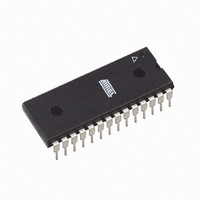ATMEGA8L-8PU Atmel, ATMEGA8L-8PU Datasheet - Page 213

ATMEGA8L-8PU
Manufacturer Part Number
ATMEGA8L-8PU
Description
IC AVR MCU 8K 8MHZ 3V 28DIP
Manufacturer
Atmel
Series
AVR® ATmegar
Datasheets
1.ATMEGA8L-8MU.pdf
(25 pages)
2.ATMEGA8L-8MU.pdf
(302 pages)
3.ATMEGA8-16PU.pdf
(305 pages)
Specifications of ATMEGA8L-8PU
Core Processor
AVR
Core Size
8-Bit
Speed
8MHz
Connectivity
I²C, SPI, UART/USART
Peripherals
Brown-out Detect/Reset, POR, PWM, WDT
Number Of I /o
23
Program Memory Size
8KB (4K x 16)
Program Memory Type
FLASH
Eeprom Size
512 x 8
Ram Size
1K x 8
Voltage - Supply (vcc/vdd)
2.7 V ~ 5.5 V
Data Converters
A/D 6x10b
Oscillator Type
Internal
Operating Temperature
-40°C ~ 85°C
Package / Case
28-DIP (0.300", 7.62mm)
Cpu Family
ATmega
Device Core
AVR
Device Core Size
8b
Frequency (max)
8MHz
Interface Type
SPI/TWI/USART
Total Internal Ram Size
1KB
# I/os (max)
23
Number Of Timers - General Purpose
3
Operating Supply Voltage (typ)
3.3/5V
Operating Supply Voltage (max)
5.5V
Operating Supply Voltage (min)
2.7V
On-chip Adc
6-chx10-bit
Instruction Set Architecture
RISC
Operating Temp Range
-40C to 85C
Operating Temperature Classification
Industrial
Mounting
Through Hole
Pin Count
28
Package Type
PDIP
Processor Series
ATMEGA8x
Core
AVR8
Data Bus Width
8 bit
Data Ram Size
1 KB
Maximum Clock Frequency
8 MHz
Number Of Programmable I/os
23
Number Of Timers
3
Operating Supply Voltage
2.7 V to 5.5 V
Maximum Operating Temperature
+ 85 C
Mounting Style
Through Hole
3rd Party Development Tools
EWAVR, EWAVR-BL
Minimum Operating Temperature
- 40 C
Controller Family/series
AVR MEGA
No. Of I/o's
23
Eeprom Memory Size
512Byte
Ram Memory Size
1KB
Cpu Speed
8MHz
Rohs Compliant
Yes
For Use With
ATSTK600-TQFP32 - STK600 SOCKET/ADAPTER 32-TQFPATSTK600-DIP40 - STK600 SOCKET/ADAPTER 40-PDIP770-1007 - ISP 4PORT ATMEL AVR MCU SPI/JTAGATAVRISP2 - PROGRAMMER AVR IN SYSTEMATSTK500 - PROGRAMMER AVR STARTER KIT
Lead Free Status / RoHS Status
Lead free / RoHS Compliant
Available stocks
Company
Part Number
Manufacturer
Quantity
Price
Company:
Part Number:
ATMEGA8L-8PU
Manufacturer:
BROADCOM
Quantity:
101
Company:
Part Number:
ATMEGA8L-8PU
Manufacturer:
ATMEL
Quantity:
33 600
Part Number:
ATMEGA8L-8PU
Manufacturer:
ATMEL/爱特梅尔
Quantity:
20 000
Company:
Part Number:
ATMEGA8L-8PU-QS096
Manufacturer:
ATMEL
Quantity:
56
Performing Page Erase by
SPM
Filling the Temporary Buffer
(Page Loading)
Performing a Page Write
Using the SPM Interrupt
Consideration While Updating
BLS
Prevent Reading the RWW
Section During Self-
Programming
2486O–AVR–10/04
Assembly Code Example for a Boot Loader” on page 216 for an assembly code
example.
To execute page erase, set up the address in the Z-pointer, write “X0000011” to
SPMCR and execute SPM within four clock cycles after writing SPMCR. The data in R1
and R0 is ignored. The page address must be written to PCPAGE in the Z-register.
Other bits in the Z-pointer will be ignored during this operation.
•
•
To write an instruction word, set up the address in the Z-pointer and data in R1:R0, write
“00000001” to SPMCR and execute SPM within four clock cycles after writing SPMCR.
The content of PCWORD in the Z-register is used to address the data in the temporary
page buffer. The temporary buffer will auto-erase after a page write operation or by writ-
ing the RWWSRE bit in SPMCR. It is also erased after a System Reset. Note that it is
not possible to write more than one time to each address without erasing the temporary
buffer.
Note:
To execute page write, set up the address in the Z-pointer, write “X0000101” to SPMCR
and execute SPM within four clock cycles after writing SPMCR. The data in R1 and R0
is ignored. The page address must be written to PCPAGE. Other bits in the Z-pointer
must be written to zero during this operation.
•
•
If the SPM interrupt is enabled, the SPM interrupt will generate a constant interrupt
when the SPMEN bit in SPMCR is cleared. This means that the interrupt can be used
instead of polling the SPMCR Register in software. When using the SPM interrupt, the
Interrupt Vectors should be moved to the BLS section to avoid that an interrupt is
accessing the RWW section when it is blocked for reading. How to move the interrupts
is described in “Interrupts” on page 44.
Special care must be taken if the user allows the Boot Loader section to be updated by
leaving Boot Lock bit11 unprogrammed. An accidental write to the Boot Loader itself can
corrupt the entire Boot Loader, and further software updates might be impossible. If it is
not necessary to change the Boot Loader software itself, it is recommended to program
the Boot Lock bit11 to protect the Boot Loader software from any internal software
changes.
During Self-Programming (either page erase or page write), the RWW section is always
blocked for reading. The user software itself must prevent that this section is addressed
during the self programming operation. The RWWSB in the SPMCR will be set as long
as the RWW section is busy. During Self-Programming the Interrupt Vector table should
be moved to the BLS as described in “Interrupts” on page 44, or the interrupts must be
disabled. Before addressing the RWW section after the programming is completed, the
user software must clear the RWWSB by writing the RWWSRE. See “Simple Assembly
Code Example for a Boot Loader” on page 216 for an example.
Page Erase to the RWW section: The NRWW section can be read during the page
erase.
Page Erase to the NRWW section: The CPU is halted during the operation.
Page Write to the RWW section: The NRWW section can be read during the page
write.
Page Write to the NRWW section: The CPU is halted during the operation.
If the EEPROM is written in the middle of an SPM page Load operation, all data loaded
will be lost.
ATmega8(L)
213

















